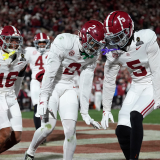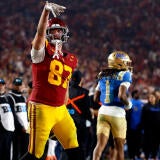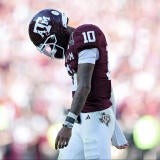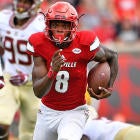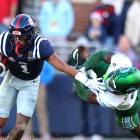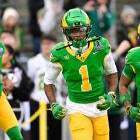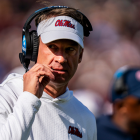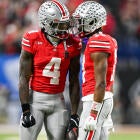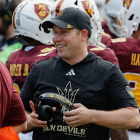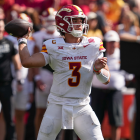Is offense dominating too much in college football? Tough call as games get longer
Competitive balance, player safety and fan enjoyment are all reasons the NCAA could shorten games

Inside the SEC office this winter in Birmingham, Alabama, three SEC employees are going through the mind-numbing task of retiming several college football games as if different playing rules applied.
How many plays might be lost and how much actual time could be saved if the game clock kept running after first downs? What if the clock started after incompletions on the ready-for-play signal? These questions are now getting asked as the average Football Bowl Subdivision game steadily grows longer, having reached three hours and 24 minutes in 2016 -- up 12 minutes from 2010.
The work by SEC officiating coordinator Steve Shaw, director of video operations Cole Cunningham and video assistant Robert Milligan is not an inexact science. Through side-by-side cut-ups of video from coaches film and television broadcasts, they are analyzing different kinds of games -- such as those with lots of incompletions and others without many passes -- to come up with ballpark numbers on saved time.
“The offense right now completely controls the tempo of the game,” Shaw said. “But if you change the rules, you can change the behavior of a team. You may see ball-control teams that, on an incomplete pass, literally slow down and let that whole time run. You could have up-tempo teams speed up and be ready to snap because there’s more urgency with the clock moving. What would those rules mean as it looks today? I don’t think anybody has the answer to that.”
The SEC plans to provide its results for the Division I Football Competition Committee and NCAA Football Rules Committee meetings in late February and early March. The ACC did a similar study by examining eight games and found a “few minutes” would be saved with a running clock after first downs or if the clock started after incompletions, ACC officiating coordinator Dennis Hennigan said.
No major actions on game lengths are expected in 2017 since this is an off year for rules changes unrelated to player safety. But there’s a multi-faceted, big-picture conversation starting to occur again related to game lengths that involve fan enjoyment, player safety and competitive balance. They’re all intertwined to these central questions: Has college football shifted too much to offense, and if so, is there a desire to swing the pendulum back?
The stats don’t lie.
CBS Sports analyzed some key offensive stats over eight-year intervals since the 1940s. (We picked eight years in order to avoid comparing the 2006 season, which was an outlier with far fewer plays and dramatically less offense because of changes to the clock rules that lasted only one season.)
From 2009-16, FBS scoring, total yards, rushing yards, passing yards and plays increased by the highest percentage over an eight-year period since the 1960s. It’s worth noting that total yards per play (a record 5.83) was up 4 percent from 2009 -- nearly the same rate as 2001-08 and in line with other eight-year intervals.
Offensive plays have periodically fluctuated in college football history, but when looking at them over a wide timespan, they decreased by 10 percent from 1968-2008. Now plays are up 6 percent since 2009, though they have plateaued in the past five years.
“There’s a growing sense on the administrator side we need to make sure we’re keeping an eye on length of game,” said NCAA associate director Ty Halpin, the liaison for the football rules committee. “Certainly, the television partners are part of that. But there’s also a factor of how attractive it is to spend your entire Saturday at a game. Plenty of people want to continue to do that, but we have to make sure the next generation of fans also want to be a part of that.”
FBS trends on offense
| Period | Scoring | Plays | Total Yds/Gm | Yds/Play | Rush Yds/Gm | Pass Yds/Gm |
|---|---|---|---|---|---|---|
2009-16 | +11% | +6% | +9% | +4% | +18% | +5% |
2001-08 | 0% | -5% | -3% | +3% | -2% | -3% |
1993-2000 | +7% | +1% | 0% | -1% | -7% | +6% |
1985-92 | +2% | +1% | 0% | +2% | -2% | +2% |
1977-84 | +6% | 0% | +6% | +6% | -14% | +35% |
1969-76 | -7% | -6% | -2% | +4% | +16% | -21% |
1961-68 | +33% | +22% | +26% | +3% | +2% | +67% |
1953-60 | -9% | +1% | -2% | -3% | -4% | +2% |
1946-52 | +14% | +15% | +20% | +4% | +16% | +27% |
* Period is seven years as the NCAA record books did not list statistics in 1945.
American Football Coaches Association executive director Todd Berry said style of play can’t largely explain why games are longer since teams in lower divisions run similar offenses in shorter games. FCS game lengths averaged 3:05 in 2016 -- up 10 minutes over two years – while Division II averaged 2:48 and Division III was 2:40.
Berry believes any dramatic rules changes, such as a running clock after first downs, would need to apply for every NCAA division. Otherwise, he said lower divisions would be averaging two-and-a-half hour games. Still, Berry notices the games are too long.
“I went to eight or nine games this year, and by midway through the third quarter, I was getting tired,” Berry said. “I never recognized it as a coach because you have so many things you’re thinking about. But for the spectator, you can only watch the entertainment on the field during breaks so many times before it gets really old.”
Finding a “right” answer on what’s best isn’t simple. So many offensive-minded head coaches are attached to prolific offenses that strategically run up the play count, as Clemson did with 99 plays to wear down Alabama and win the national championship. Meanwhile, many defensive coaches would like a little help with the playing rules.
Deciding what’s best for the game must start by agreeing on targets. What’s the right length of time for fans to watch a game? What’s the right number of plays for the safety of players? What’s the right competitive balance between offenses and defenses?
Since the answers reside in the eye of the beholder and are based on self-interest, we turned for some help in framing the dialogue to the officiating community -- the only real neutral observers in college football.
Competitive balance
Most officiating supervisors agree on the biggest reason why games are longer: more offense and more plays. First downs stop the clock. Incompletions stop the clock. Touchdowns stop the clock for several minutes to set up the extra point, allow TV to go to commercial and then manage the kickoff.
It’s easy to suggest this stretch of offensive dominance is simply a cycle that will pass. After all, the argument goes, we’ve been here before. The wishbone arrived many decades ago by ripping apart defenses, which learned to defend it and brought the game’s pendulum back.
But that’s not what’s happening now, according to many officiating coordinators. They think offenses will continue to control the game unless changes are made.
“Of course the rules are geared for the offense,” said Big Ten officiating coordinator Bill Carollo, who is also an NFL referee. “We’ve talked about it for a couple years. You hear, ‘Well, a couple years isn’t quite a trend.’ You have to have the right data.”
Then again, offensive dominance may be what the majority of people in college football want.
“I’m not sure I’d say it’s out of whack, but over time the rules have tended to shift the balance toward the offense,” said Rogers Redding, the national officiating coordinator and NCAA secretary-rules editor. “It’s an exciting game. Fans like to see a lot of offense. That’s not a bad thing at all. It just has changed the nature of the game a little bit. It has changed the length of games.”
When the NCAA in 2008 shifted from a 25-second play clock to 40 seconds -- the same as the NFL -- the expectation was the change wouldn’t drastically affect the game.
“When the NFL went to the 40-second clock, they found it didn’t have much impact on total elapsed time,” Redding said in 2008. “It was a matter of getting more plays in, and that’s up to the offense. It’s not as if we’re reinventing the wheel. We’ve been able to see how it worked in the NFL for a number of years.”
But college football differs from the NFL, largely due to embracing creative offenses rarely seen in the pros. That’s a selling point many fans and people in the game enjoy. In hindsight, Redding said, the unintended consequence of the 40-second clock was shifting the pace of games almost entirely to the offense, which now rarely huddles and can play fast or adjust at the line of scrimmage based on how the defense is aligned.
Two years ago, defenses looked like they would get some help to defend the increasing popularity of run-pass options (RPOs) with dual-threat quarterbacks. The NCAA Football Rules Committee changed the ineligible receiver downfield rule from 3 yards to 1 yard. The NCAA Playing Rules Oversight Panel (PROP) tabled the idea after pushback from some high-profile offensive coaches, including Gus Malzahn, Art Briles, Hugh Freeze, Todd Graham and Dabo Swinney.
At the time, 57 percent of the FBS head coaches supported changing the rule to 1 yard. But PROP expressed concern that only 65 of the 120 FBS coaches participated in the survey and only 46 coaches offered comments.
Two years later, American Athletic Conference officiating coordinator Terry McAulay said even some offensive-minded head coaches in his league now “despise” the ineligible man downfield rule at 3 yards and view it as the most unfair rule in the game.
“For the handful of coaches that got PROP to change the rule back to 3 yards, that really was one of the biggest disservices I’ve seen in a long time,” said McAulay, who is an NFL referee. “That wasn’t PROP’s job to do that. Now they’ve put the fear in the rules committee to not look strongly at it, even though we desperately need it. It’s easier to officiate at 1 yard, and it’s better for defenses. I don’t think we’ll get there anytime soon.”
Hennigan, the ACC officiating coordinator, said defensive coaches’ biggest complaints of rules are ineligible man downfield and the lack of offensive pass interference if a throw doesn’t cross the line of scrimmage. Those two rules can allow for a wall of downfield blockers in which ball carriers are “basically walking down the field,” said Big 12 officiating coordinator Walt Anderson, another NFL referee.
Nowhere does defense get ignored more than in the Big 12. Since 2011, only one Big 12 defense has allowed fewer than 20 points per game (TCU, 2014). That’s the fewest for any FBS conference and well behind the SEC (23 defenses below 20 points) and Big Ten (21 defenses). In 2016, the Big 12’s best scoring defense was ranked 25th nationally (Kansas State) and best defense in yards per play was 48th (Baylor).
This year, Anderson is proposing that the NCAA Football Rules Committee discuss creating rules similar to the NFL that better restrict who can be an eligible receiver at the line of scrimmage. Anderson said he has no issue with pace of play, but he believes the defense is unfairly disadvantaged by having no control over very liberal offensive formations.
“I can show you so much video of teams using the exact same formation play after play at a fast pace, and all of a sudden you do something just vaguely different, and the defense does not have time to recognize that,” Anderson said. “You could put someone [defending] the left tackle that’s wearing No. 85, and they move No. 75 to the right, and the defensive back isn’t looking over there and now No. 75 runs downfield totally uncovered because for 10 plays he was the left tackle and now he’s the tight end.”
Pac-12 officiating coordinator David Coleman pointed out some rules are starting to help defenses. For instance, the NCAA last year changed instances when offensive players can’t block below the waist, a topic that will be revisited in 2017.
The targeting rule, created in 2013 for safety purposes, has changed how defensive players must tackle. The NCAA is expected to be more lenient on ejections in 2017 by requiring replay to confirm that targeting occurred before a player is thrown out.
“I think the defenses are starting to catch up to the no-huddle concept,” said Berry, the AFCA executive director. “The speed of the game changed dramatically for the defense, and their personnel was bigger with defensive calls built around being able to huddle. Now, I feel like most defenses are looking for one signal, and players are a little smaller and more versatile to play different positions. Our game is pretty popular. I don’t think our coaches want to overreact to try to balance the game.”
Player safety
As offensive styles added more plays, so did college football’s leaders by adding more games over the past decade. That means more hits accumulating on players’ bodies and more chances to get hurt.
The 2016 AP All-Americans at quarterback, running back, wide receiver and all-purpose player combined for 4,810 touches (defined for these purposes as carries, passes, receptions and kick/punt returns). That’s 11 percent more touches than those same positions from the AP All-America team in 2005 -- the last season with 11 regular-season games and prior to the postseason expanding even more.
The additional touches are largely due to dual-threat quarterbacks. From 2014-16, Clemson’s Deshaun Watson put more than an extra year’s worth of pass attempts and carries on his body than Texas’ Vince Young accumulated from 2003-05. If Louisville uses Heisman Trophy winner Lamar Jackson the same way in 2017 as he was used last year, he will surpass Watson’s three-year usage total by 107 touches.
“I don’t think that’s a stat we want,” McAulay said. “Coaches always want more plays. But yes, we need to cut some plays out of the game.”
The NCAA’s health and safety department has found no direct correlation between the number of plays and injuries at this point, said Halpin, the NCAA liaison for the football rules committee.
“You’d think in the fourth quarter that would be when a lot of injuries occur, and that’s not the case based on what they have,” Halpin said. “It doesn’t mean we won’t continue to look at it. Of course, the number of plays means more exposure and it leads to that concern, but we haven’t found anything in our data to underscore that.”
Total touches for AP All-Americans
| Position | 2016 | 2005 |
|---|---|---|
| QB | Lamar Jackson, 669 | Vince Young, 480 |
| QB | Deshaun Watson, 744 | Matt Leinart, 483 |
| QB | Baker Mayfield, 436 | Brady Quinn, 520 |
| RB | D’Onta Foreman, 330 | Reggie Bush, 285 |
| RB | Dalvin Cook, 321 | Jerome Harrison, 333 |
| RB | Donnel Pumphrey, 378 | DeAngelo Williams, 325 |
| RB | Christian McCaffrey, 314 | Brian Calhoun, 402 |
| RB | Saquon Barkley, 303 | Laurence Maroney, 303 |
| RB | Aaron Jones, 258 | LenDale White, 211 |
| WR | Dede Westbrook, 106 | Dwayne Jarrett, 96 |
| WR | Corey Davis, 99 | Mike Hass, 92 |
| WR | Zay Jones, 163 | Jeff Samardzija, 86 |
| WR | John Ross, 106 | Calvin Johnson, 54 |
| WR | Amba Etta-Tawo, 94 | Greg Jennings, 133 |
| WR | Austin Carr, 90 | Derek Hagan, 77 |
| AP | Curtis Samuel, 177 | Maurice Drew, 237 |
| AP | Quadree Henderson, 116 | Brandon Williams, 115 |
| AP | Christian Kirk, 106 | Skyler Green, 93 |
| Total touches = passes, carries, receptions, kick/punt returns | ||
Anderson said many officiating coordinators believe collecting better injury data is needed to determine the best rules for safety. The problem, Anderson said, is teams don’t feel comfortable publicly reporting who’s hurt -- a mechanism the NFL requires with weekly injury reports.
“That kind of information would be so valuable if you had data universally and consistently collected to show whether more plays and getting tired translates to injuries,” Anderson said. “I do think we need to be aware that the length of game is starting to get up into an area where, when you combine it with the number of plays, is probably more than what’s appropriately safe for the players.”
College football has been here before. In 2014, the NCAA Football Rules Committee proposed making offenses wait 10 seconds before snapping the ball. The idea got scrapped due to backlash from up-tempo coaches and a lack of hard evidence to correlate plays and injuries.
University of Michigan NeuroSport Research Laboratory director Steven Broglio said in 2014 that correlations between up-tempo offenses and injuries were speculative. Broglio, who is helping the NCAA and Department of Defense study the natural history of concussions, said this month he hasn’t done more research on the question of style of play.
In a 2013 study of two high school teams, Broglio found that 50 percent more head impacts occurred with a traditional run-first offense than a spread, pass-first offense. However, higher-impact hits occurred with the pass-heavy team because players found themselves in more space to receive high-velocity hits. Colleges tend to run a variety of spread offenses.
A 2015 study published in the Orthopedic Journal of Sports Medicine concluded that NFL players who are most involved in pass plays appear to be at increased risk for concussions. The study analyzed documented NFL concussions from 2012-14 and found more concussions among players in the West Coast offense. The authors wrote that may be because those receivers move laterally across the field at an increased risk for concussions and because the West Coast offense runs the ball more and thus leads to more subconcussive head impacts.
Ivy League executive director Robin Harris, whose conference has studied player safety for several years, said she hasn’t heard of any examinations looking at the correlation between plays in a game and player injuries.
Carollo, the Big Ten officiating coordinator, said he believes more plays result in more players getting hurt. He acknowledged his opinion is anecdotal and not traced to any study.
“Sure, you can get injured on the opening kickoff,” he said. “But when you’re tired on the field and slowing down physically and mentally and you take a blind-side hit, you’re going to get injured or pull something. I think there’s something there.”
Fan enjoyment
When Shaw gets to the SEC office on Monday mornings during football season, he doesn’t find his voicemail filled with fans complaining that games are too long. So when he hears that complaint from the public or within the sport, he counters with a question: “What time are we shooting for? You’ve got to have a target before you start down a path.”
The average length of games in FBS ranged from 3:16 (Sun Belt) to 3:34 (Mountain West). The Big 12, with its defensive woes, had the longest games for Power Five conferences at 3:33.
“The culture of the college game is very different than the culture of the NFL game, and for good reasons for both groups because they each have somewhat of a unique niche,” said Anderson, the Big 12 officiating coordinator. “If NFL games averaged 3:33, it would be an issue. Even with NFL games somewhere around 3:05, they don’t want it to go any longer.”
In the short term, look for conferences to try to cut some time off incrementally. Some are looking at being more efficient to restart games after TV returns from commercial, and getting in and out of halftime at the prescribed 20-minute allotment.
“Even though we say halftime is 20 minutes, we’re giving them 23, 24 minutes,” Carollo said. “We need to get the players back at 18 minutes, huddling at 19 and kicking off at 20.”
Still, there’s a broader concern. Even if incremental adjustments to halftime and commercial breaks work, will they be enough in the future? If nothing major changes to curb offense, what would cause record scoring and longer games to consistently subside? Historically, offensive statistics always increase. But they’ve rarely gone up this much over nearly a decade.
One unique clock idea being studied is to treat incomplete passes like a ball carrier that runs out of bounds. The clock would stop on the incompletion, but restart on the ready-for-play signal when the ball is set.
“I think it’s a reasonable approach to take because we already have precedent on how the clock is treated when the ball carrier goes out of bounds,” said Redding, the national officiating coordinator.
Several officiating coordinators said the only level of football they can recall using a winding clock after incompletions was NFL Europe, which folded in 2007. Anderson, who worked in NFL Europe, said the league aimed to play games in 2:40 and averaged around 2:45.
“I think running the clock after first downs makes more sense,” Anderson said. “Stopping the clock to move the chains was something that was done years ago for reasons that just don’t apply anymore in terms of how we officiate the game. We don’t even worry about moving the chains anymore. We just move the down box.”
Coaches will have a big say in what the game’s future looks like. This year, the NCAA intentionally held off its rules survey to coaches until after recruiting. The hope is coaches will pay more attention in February and offer better feedback than in June, when the surveys used to arrive.
“The surveys have not been very well received,” said Berry, the AFCA executive director. “I’ve tried to work with the NCAA on the timing. I prefer to meet with guys and discuss topics rather than survey them.”
Others with major roles in figuring out the rules will be the Football Oversight Committee (chaired by Big 12 commissioner Bob Bowlsby) and the Division I Football Competition Committee (chaired by Arizona State athletic director Ray Anderson, who used to work closely with the NFL’s competition committee). Mississippi State’s Dan Mullen is the only coach on the oversight committee. The coaches on the competition committee are South Alabama’s Joey Jones, North Carolina’s Larry Fedora and Wyoming’s Craig Bohl.
Ultimately, college football may decide its game only needs some tweaks and not wholesale changes.
“There’s a competitive balance issue to discuss,” Shaw said. “What’s good for the game? What’s good for the players? Our society is changing. You and I may love a good, old-fashioned 7-3 game, but maybe our society has moved beyond that.”
That is entirely possible. Still, as fans sit through longer games, players accumulate more hits on their bodies, and offenses dominate the sport, the questions will persist.


